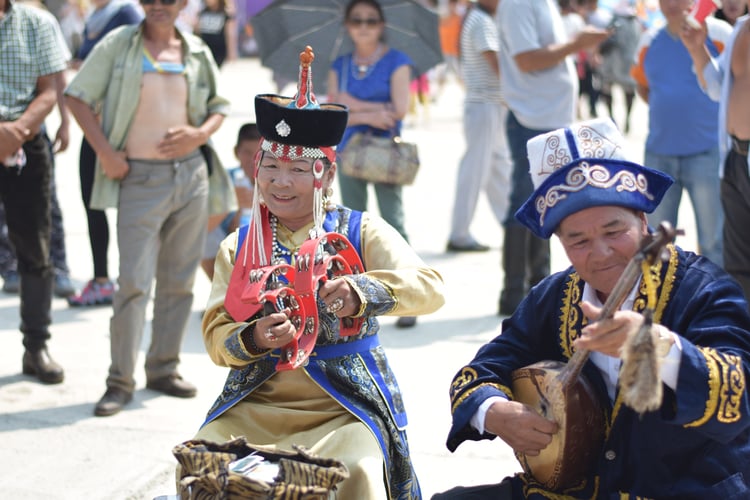Music is not the universal language. Hear me out.
I don't mean to rebel against the idea that music can be unifying. But it can be just as diverse as spoken language! It unites us, not because we all understand or enjoy it in the same way, but by helping us celebrate the beauty of our differences. It is a window into another culture. Today's window looks in on Mongolia and the rich musical heritage found there. There’s nothing quite like experiencing the music for yourself, so here are some instructions to get the most out of this post:
- Play the link at the beginning of each section and let it keep playing as you read.
- Get ready to fall in love with a beautiful new culture.

Long Song — Mongol Song - Urtiin Duu
Now that the music is playing, take a moment to let it sink in.
This is Urtiin Duu (long song), a tradition up to 2,000 years old. The long, ornamented syllables express Mongolia’s slower pace, a reflection of the deep cultural roots of this way of life. It is usually performed at celebrations: a birth, a wedding, or a holiday. This example is from a Tsagaan Sar (lunar new year) festival, and the singers are professionals. But in Mongolia, singing is not just for the gifted. Folk songs like this are shared and sung by everyone.
Throat Singing — Mongolian Throat Singing With My Daughter
I love how this singer brings his daughter into the tradition! When her voice cracks, they don’t stop and do another take—they just smile. It’s part of the music! Mongolians certainly appreciate excellence, but the point is not to be the best. It is about tradition and community. Art in many western cultures is about self-expression, but that isn’t the point in Mongolia. Music is something to gather around, connecting communities to each other, the legacy of their ancestors, and the land.
Now, it would be a mistake to listen to this example without discussing the amazing Mongolian throat singing (Khoomei)! On a scientific level, the two notes at once are created by changing the shape of the mouth to amplify overtones. But on a deeper level, the sounds come out of the country itself. Everything in the traditional nomadic culture of Mongolia’s history is tied to the land. Khoomei echoes the sounds of winds, streams, and animals in the beautiful landscape of its origin. It can be sung in praise of the everyday or the extraordinary. Throughout its history it has been used very practically in herding animals and very spiritually, as it is tied to the animistic culture of this area.
Traditional Instruments — Traditional Mongolian Ethnic Music Group "Khusugtun" (Хөсөгтөн)
This veneration for the land and the animals, especially horses, of the countryside is also expressed in the traditional instruments of Mongolia. The moorin huur (horsehead fiddle) is the bowed instrument played by the two musicians on the left in this video. In addition to the beautifully carved scroll in the shape of a horse’s head, the strings and the bow are made from horse tail hair. The instrument is meant to sound a bit like a horse as well (there is a clear example of this in one of the links below). The energy of this song, completely different from the Urtiin Duu, races along with the galloping horses stolen by the Robin Hood-like Toroi Bandi, a great hero of Mongolian tradition. Heroes, horses, and the land are common topics for Mongolian songs.
Now be honest: when you hit play on that first video, what was your reaction? Maybe you loved it right away, but maybe it wasn’t your cup of tea. After all, it is very different from what most of us westerners are used to hearing. But that’s the beauty of it, the world is interesting and beautiful because of the rich variety that fills it. This is true from the land itself to the people who inhabit it and all of the amazing culture they create.
Links
Learn more about Khoomei and the group Khusugtun: Khusugtun - Mongolian music in London - BBC Proms 2011 Human Planet
Listen to a clear example of a horse-head fiddle mimicking a horse's whinny at minute 1:15. https://www.youtube.com/watch?v=uAbeIgVQWqc
Explore Recordings of Mongolian music geographically with this interactive map: https://www.mongolmusicarchive.com/
------------------------------------------------------------------------
- https://ich.unesco.org/en/RL/urtiin-duu-traditional-folk-long-song-00115#:~:text=The%20Urtiin%20duu%20or%20%E2%80%9Clong,honoured%20role%20in%20Mongolian%20society
- https://elifesciences.org/articles/50476#s2
- https://www.mongoliacenter.org/mongol-music-archive-capturing-everyday-uses-of-traditional-music-in-the-daily-lives-of-mongolian-herders/
- https://www.pilotguides.com/articles/throat-singers-of-tuva/
- https://www.britannica.com/art/horsehead-fiddle
- https://www.theatlantic.com/health/archive/2009/06/tasting-history-in-mongolian-spring/19071/2

